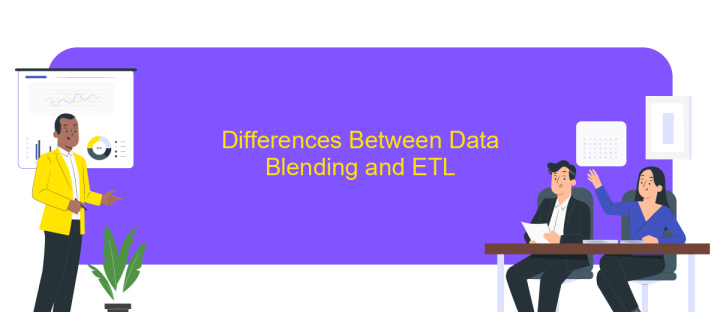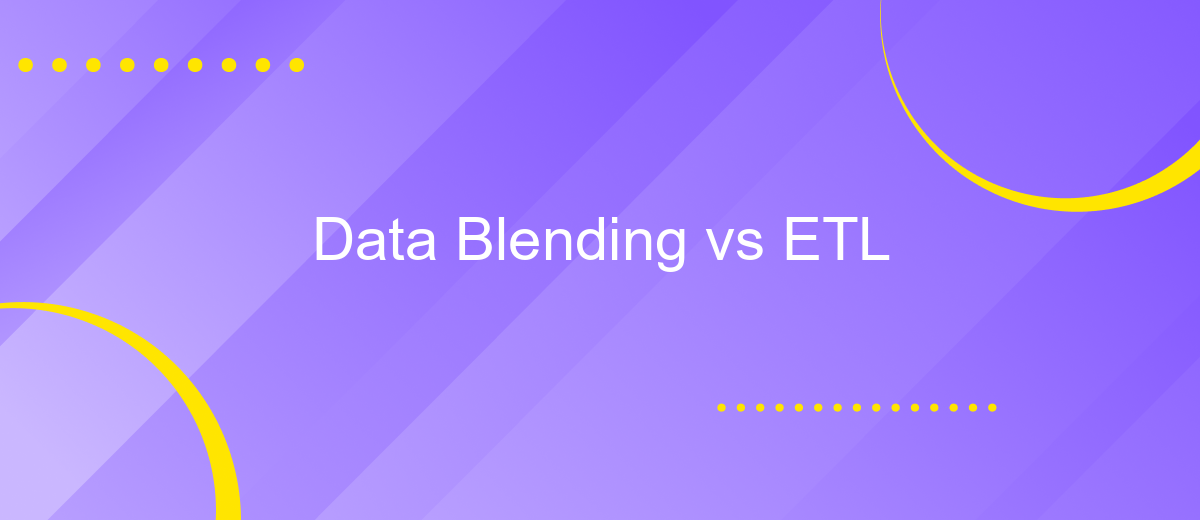Data Blending vs ETL
In today's data-driven world, organizations are constantly seeking efficient ways to manage and analyze vast amounts of data. Two key methodologies that stand out are Data Blending and ETL (Extract, Transform, Load). While both aim to integrate data from various sources, they serve distinct purposes and offer unique advantages. This article explores the differences, benefits, and use cases of Data Blending versus ETL.
Data Blending Overview
Data blending is a technique used to combine data from multiple sources into a single, unified view. Unlike traditional ETL (Extract, Transform, Load) processes, data blending does not require extensive data warehousing or complex transformations. Instead, it focuses on merging datasets quickly and efficiently to provide actionable insights.
- Combines data from various sources
- Requires minimal data transformation
- Provides quick and actionable insights
One of the tools that facilitate data blending is ApiX-Drive, a service that allows seamless integration of multiple data sources. With ApiX-Drive, users can automate data flows between different applications without the need for extensive coding or technical expertise. This makes it easier to blend data from various platforms and generate comprehensive reports in real-time.
ETL Overview

ETL, which stands for Extract, Transform, Load, is a fundamental process in data management and integration. The ETL process begins with the extraction of data from diverse sources, such as databases, APIs, and flat files. This data is then transformed to fit operational needs, which may include cleansing, aggregating, and enriching the data. The final step is loading the transformed data into a target data warehouse or another storage system, where it can be analyzed and utilized for decision-making.
Modern ETL tools and services, like ApiX-Drive, have streamlined this process by offering automated workflows and easy-to-use interfaces. ApiX-Drive, for example, allows users to set up integrations without extensive coding knowledge, enabling seamless data extraction from various sources and automated transformations. This reduces the complexity and time required to manage data pipelines, making it easier for businesses to harness their data for analytics and reporting. By simplifying the ETL process, services like ApiX-Drive empower organizations to focus more on deriving insights and less on data wrangling.
Differences Between Data Blending and ETL

Data Blending and ETL (Extract, Transform, Load) are two distinct approaches to data integration that serve different purposes. While both methods aim to consolidate data from multiple sources, they differ significantly in their processes and use cases.
- Purpose: Data Blending is primarily used for data analysis and visualization, whereas ETL is designed for data warehousing and long-term storage.
- Process: Data Blending combines data on-the-fly from multiple sources without significant transformation, while ETL involves extracting data, transforming it into a consistent format, and loading it into a data warehouse.
- Complexity: Data Blending is generally simpler and faster to set up, making it ideal for quick insights. ETL processes are more complex and require extensive setup and maintenance.
- Tools: Data Blending often utilizes tools like Tableau, while ETL relies on platforms such as Apache Nifi, Talend, and services like ApiX-Drive for seamless integration and automation.
In summary, choosing between Data Blending and ETL depends on the specific needs of your organization. For quick, flexible data analysis, Data Blending is ideal. For robust, long-term data integration, ETL is the better choice. Tools like ApiX-Drive can facilitate both processes by providing easy-to-use integration solutions.
Benefits of Data Blending

Data blending offers a streamlined approach to combining data from multiple sources without the need for complex ETL processes. This method allows businesses to quickly integrate and analyze data, leading to faster decision-making and more agile operations.
One of the main advantages of data blending is its flexibility. Unlike traditional ETL processes, which can be time-consuming and require extensive coding, data blending tools often come with user-friendly interfaces that make it easier for non-technical users to combine data from various sources.
- Faster data integration
- Enhanced data accuracy
- Reduced dependency on IT resources
- Improved decision-making capabilities
Moreover, services like ApiX-Drive simplify the data blending process by offering seamless integrations with numerous platforms. This enables businesses to automate data flows and ensure that their data is always up-to-date, thus maximizing efficiency and productivity.
Benefits of ETL
ETL (Extract, Transform, Load) offers several advantages that make it an essential process in data management. One of the primary benefits is its ability to handle large volumes of data efficiently. ETL processes can extract data from multiple sources, transform it into a consistent format, and load it into a data warehouse for analysis. This ensures that businesses can leverage accurate and timely data for decision-making. Moreover, ETL tools often come with robust error handling and data validation features, which help maintain data integrity and quality.
Another significant benefit of ETL is its ability to automate data workflows. Platforms like ApiX-Drive facilitate seamless integration between various data sources and destinations, reducing the need for manual intervention. This automation not only saves time but also minimizes the risk of human errors. Additionally, ETL processes can be scheduled to run at specific intervals, ensuring that data is always up-to-date. This continuous data flow is crucial for real-time analytics and reporting, enabling businesses to respond quickly to changing market conditions and make informed decisions.
FAQ
What is the main difference between Data Blending and ETL?
When should I use Data Blending instead of ETL?
Can Data Blending handle large volumes of data efficiently?
Is it possible to automate Data Blending and ETL processes?
Do I need technical skills to perform Data Blending and ETL?
Apix-Drive is a universal tool that will quickly streamline any workflow, freeing you from routine and possible financial losses. Try ApiX-Drive in action and see how useful it is for you personally. In the meantime, when you are setting up connections between systems, think about where you are investing your free time, because now you will have much more of it.

